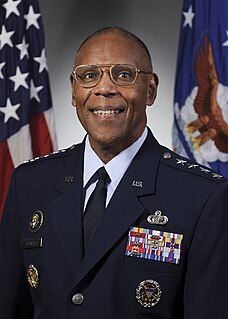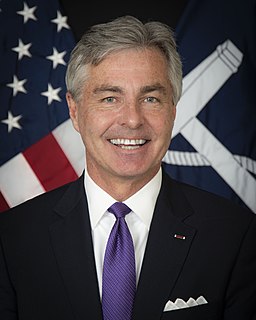
The United States secretary of defense (SecDef) is the leader and chief executive officer of the United States Department of Defense, the executive department of the U.S. Armed Forces. The secretary of defense's position of command and authority over the military is second only to that of the president of the United States, who is the commander-in-chief. This position corresponds to what is generally known as a defense minister in many other countries. The secretary of defense is appointed by the president with the advice and consent of the Senate, and is by custom a member of the Cabinet and by law a member of the National Security Council.

United States Space Command is a unified combatant command of the United States Department of Defense, responsible for military operations in outer space, specifically all operations 100 kilometers above mean sea level. U.S. Space Command is responsible for the operational employment of space forces that are provided by the services of the United States Armed Forces, predominantly the United States Space Force.

Michael R. Lehnert is a retired major general of the United States Marine Corps. He supervised the construction and served as the first commandant of the Guantanamo Bay Detention Camp.

James Norman Mattis is a retired United States Marine Corps four-star general who served as the 26th US secretary of defense from January 2017 to January 2019. During his 44 years in the Marine Corps, he commanded forces in the Persian Gulf War, the War in Afghanistan, and the Iraq War.

Charles Elliott Wilhelm is a decorated retired United States Marine Corps General who served two combat tours of duty in Vietnam. He later served as Commanding General of the 1st Marine Division; as a Deputy Assistant Secretary of Defense; and as the Commander, U.S. Southern Command (1997–2000). General Wilhelm retired from the Marine Corps in 2000, after 37 years of service.

James Edwin McPherson is an American government official and retired United States Navy rear admiral. He serves as the General Counsel of the Army since January 2, 2018. He served as the United States Under Secretary of the Army from March 25, 2020 to January 20, 2021 and in acting capacity from July 23, 2019 to March 25, 2020. He served as Acting United States Secretary of the Navy from April 7, 2020 to May 29, 2020, following the resignation of Thomas Modly.

John Holden Gibson II is an American businessman and government official. Gibson is the former Chief Management Officer of the United States Department of Defense. Prior to serving as CMO, Gibson served as the Deputy Chief Management Officer for the Defense Department from November 2017 to February 2018. He has been chief financial officer, chief operating officer, and managing director for several companies including a national consulting group. Gibson previously served as Deputy Under Secretary of Defense for Management Reform and as Assistant Secretary of the Air Force.

John Francis Kelly is a board member at Caliburn International and a retired U.S. Marine Corps general who served as the White House Chief of Staff for President Donald Trump from July 31, 2017, to January 2, 2019. He had previously served as Secretary of Homeland Security in the Trump administration.

John R. Allen is the president of the Brookings Institution, a retired United States Marine Corps four-star general, and former commander of the NATO International Security Assistance Force and U.S. Forces – Afghanistan (USFOR-A). On September 13, 2014, President Barack Obama appointed Allen as special presidential envoy for the Global Coalition to Counter ISIL. He was succeeded in that role by Brett McGurk on October 23, 2015. He is the co-author of Turning Point: Policymaking in the Era of Artificial Intelligence with Darrell M. West and Future War and the Defence of Europe alongside LTG (Ret.) Frederick “Ben” Hodges and Professor Julian Lindley French.

Joseph Francis Dunford Jr. is a retired United States Marine Corps four-star general, who served as the 19th Chairman of the Joint Chiefs of Staff from October 1, 2015 until September 30, 2019. He was the 36th Commandant of the Marine Corps. Dunford is the first Marine Corps officer to serve in four different four-star positions; the others include commander of the International Security Assistance Force and United States Forces – Afghanistan from February 2013 until August 2014, and as the 32nd Assistant Commandant of the Marine Corps from October 23, 2010, to December 15, 2012. He has commanded several units, including the 5th Marine Regiment during the 2003 invasion of Iraq.

The structure of the United States Army is complex, and can be interpreted in several different ways: active/reserve, operational/administrative, and branches/functional areas.

James L. Terry is a retired lieutenant general of the United States Army. Terry has commanded at multiple levels across the Army. Terry's last assignment was as the commanding general of United States Army Central, retiring 17 November 2015. Terry served as the last commander of V Corps before its inactivation in 2013. While commanding V Corps, he concurrently served as Commander, International Security Assistance Force Joint Command (IJC), and as deputy commander of United States Forces Afghanistan. He was the Commanding General of the 10th Mountain Division from 2009 to 2011.

Larry O'neil Spencer is a retired United States Air Force general who served in many command, comptroller, and leadership roles during the course of his career. Some of his leadership roles include being the Vice Chief of Staff of the United States Air Force, Commander of the 75th Air Base Wing at Hill AFB, Commander of the 72nd Support Group at Tinker AFB, and the Commander of the 4th Comptroller Squadron at Seymour Johnson AFB. He retired 1 October 2015 with more than 44 years of service. He received the Defense Distinguished Service Medal, the Air Force Distinguished Service Medal, the Defense Superior Service Medal, and the Legion of Merit.

Ricky Lynn Waddell is a lieutenant general in the United States Army Reserve who serves as the Assistant to the Chairman of the Joint Chiefs of Staff. He served as a Deputy National Security Advisor to President Donald Trump from 2017 to 2018. His promotion to lieutenant general was authorized by the United States Senate on 26 September 2019.

Mark Thomas Esper is an American manufacturing executive and politician who served as the 27th United States Secretary of Defense from July 2019 to November 2020. A member of the Republican Party, he previously was the 23rd U.S. Secretary of the Army from November 2017 to July 2019.

Kenneth John Braithwaite II is an American politician, diplomat, businessman and naval officer who served as the 77th secretary of the Navy from May 29, 2020, to January 20, 2021 in the Donald Trump administration. Prior to that, he served as the U.S. ambassador to Norway, beginning February 8, 2018. Braithwaite is a retired U.S. Navy one-star rear admiral, having served in the Iraq War.

Arnold Webster Bunch Jr. is a general in the United States Air Force. He serves as the Commander, Air Force Materiel Command, headquartered at Wright-Patterson Air Force Base, Ohio. He is responsible for installation and mission support, discovery and development, test and evaluation, life cycle management services and sustainment of virtually every major Air Force weapon system. The command employs approximately 80,000 people and manages $60 billion of budget authority annually. Before his current assignment, he was the military deputy in the Office of the Assistant Secretary of the Air Force for Acquisition at The Pentagon.

















